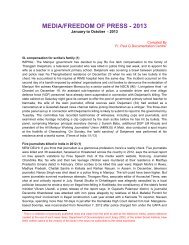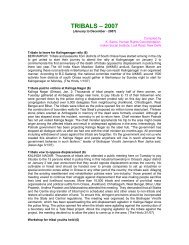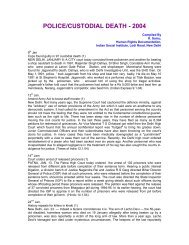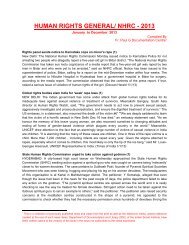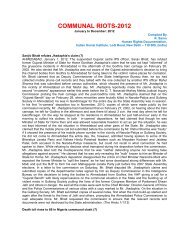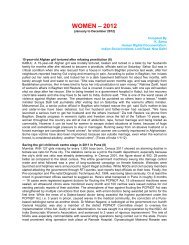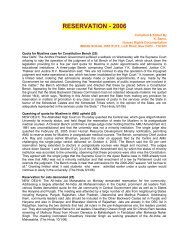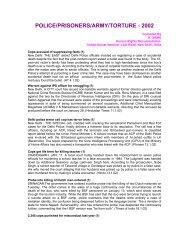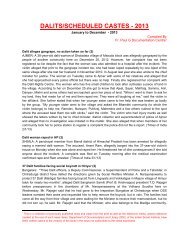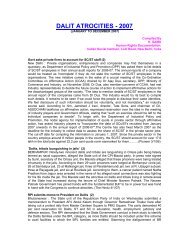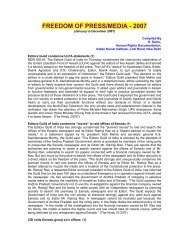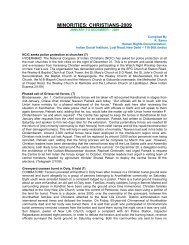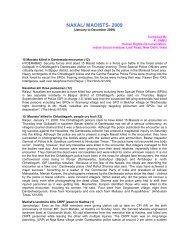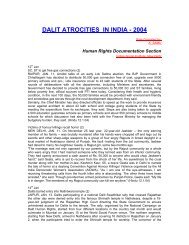You also want an ePaper? Increase the reach of your titles
YUMPU automatically turns print PDFs into web optimized ePapers that Google loves.
Hindu, present a few contestable historical facts, the bigger problem is one of omissions and<br />
commissions that lend the texts a slant typical of the Hindutva nationalist construction of <strong>Indian</strong> history.<br />
For example, the book states in its fifth standard lesson, titled ‘Veda Kalada Bharata', that cow slaughter<br />
was forbidden in the early Vedic period. The historical record, however, suggests otherwise. Historians<br />
such as D.N. Jha have shown how the Rigveda has references of beef being one of the most commonly<br />
consumed foods at the time. So indeed does K.T. Achaya in his scholarly dictionary of <strong>Indian</strong> food. A<br />
chapter titled ‘Hosa Dharmagala Udaya' (Birth of New Religions) in the Standard 8 textbook, has a<br />
highlighted box (Page 43) that makes a distinction between ‘dharma' and ‘religion'. It makes the debatable<br />
claim that even Buddhism and Jainism, like Hinduism, cannot be categorised as religions, and that only<br />
Islam and Christianity in India fit into the category. While presentation of such “facts” is one aspect, the<br />
overall tone of the textbooks, especially in the region-specific histories — introduced for the first time as<br />
separate textbooks for Bangalore, Mysore, Gulbarga and Belgaum divisions — needs closer examination.<br />
For example, the rich syncretic traditions of the northern districts of Karnataka have been either glossed<br />
over or omitted altogether in the textbooks. Aspects of the pluralist culture of the region, like Bandenawaz<br />
Dargah, and poets like Shishunala Sharief, are dispensed with in brief and de-contextualised<br />
descriptions. The Standard 5 textbook (page 106 of the draft copy) says that Bidar was originally called<br />
“Vidhura Nagara” and “Bidururu Pura”, a typical attempt to establish a Hindu past to cities and towns .<br />
The other popular explanation that Bidar has its roots in the Persian word meaning “Awakening” does not<br />
find a mention here. While the region is replete with evidence of the meeting of Sufi and Datta traditions<br />
— the shrine of Manikprabhu in Humnabad or the Savalagi Shivalingeshwara shrine near Gokak for<br />
example — these do not find a mention. The late Sham.Bha. Joshi and other scholars have established<br />
that their unique religious mix have given the Bombay-Karnataka and Hyderabad-Karnataka region a<br />
distinctly inclusive cultural character, simply not reflected in these textbooks, though they claim to present<br />
a flavour of every region to the children. The delineation of the Hyderbad Liberation Movement in the<br />
Gulbarga division's textbook is particularly striking for the manner in which it is constructed as a Hindu vs<br />
Muslim struggle. The role of the Andhra Maha Sabha in the movement, and its nationalist and antilandlord<br />
content finds no mention. The same chapter describes the Vijayanagar kings as rulers who<br />
“protected, nurtured and upheld Hindu religion and culture” for over 200 years. In its earlier draft, the<br />
Standard 5 textbook carried a map of “cultural India”, in the ‘Bharata, Namma Hemme' (India, Our Pride)<br />
chapter, showing the country boundaries encompassing the Hindukush, parts of China, and large parts of<br />
south-east Asia — representing the nationalist Hindu notion of “Akhand Bharat”. This, it is learnt, was<br />
later dropped. C.S. Dwarakanath, former chairperson of the Karnataka State Backward Classes<br />
Commission, described the draft copy as “a blatant attempt at filling children's minds with ideological,<br />
religious and political biases at a tender age.” (The Hindu 5/2/12)<br />
‘Textbooks with saffron slant will create communal discord' (26)<br />
BANGALORE, February 6, 2012: Flaying the State Government for inducing a “saffron slant” in the fifth<br />
and eighth standard social studies textbooks, which are going to be introduced in the next academic year,<br />
activists of the Students Federation of India (SFI) staged a protest here on Sunday demanding that the<br />
textbooks be withdrawn. Reading from sections of the books, SFI State president Ananth Naik pointed to<br />
instances where the Vedic and Brahminical practices of the past have been glorified. “Some of the<br />
passages clearly justify casteism and seem to suggest that there is nothing wrong with the Varna<br />
system,” he said. Arguing that textbooks should imbibe the spirit of scientific enquiry and rational thinking<br />
in children, the activists said that the BJP Government and the RSS want to reinforce and justify the<br />
dogmas of the past. The textbooks, according to the agitators, have the potential to create communal<br />
discord as they speak very disparagingly of minority communities and their faith. (The Hindu 6/2/12)<br />
VHP plans protest against Bill (26)



